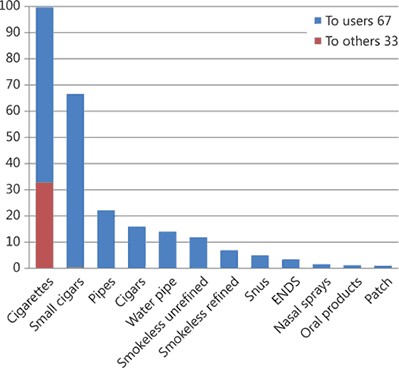
Unveiling the Astonishing Truth: Why Vaping is 95% Safer than Smoking
In 2015, Public Health England (PHE) had officially declared that “vaping is at least 95% safer than smoking”. A statement which the health organisation confirmed

In 2015, Public Health England (PHE) had officially declared that “vaping is at least 95% safer than smoking”. A statement which the health organisation confirmed in 2018, when it was time to launch its new campaign called “PHE’s Health Harms campaign”. However, despite the fact that the “95% safer” part of the news has made it across the world, most vapers are not aware of the scientific facts which led the PHE to make this declaration. Lets explore this together.
The story starts in 2014 when the PHE ordered a report [1] aiming to study the effect of vaping on health. One year later, the 2015 report, written by John Britton and Ilze Bogdanovica from the UK Centre for Tobacco and Alcohol Studies of the University of Nottingham, was presented to the organization. After inspecting the report, the PHE officially declared “the hazard associated with use of EC products currently on the market is likely to be extremely low, and certainly much lower than smoking and the health risks of passive exposure to electronic cigarette vapour are likely to be extremely low”.
The report begins by emphasizing that while electronic cigarettes do contain toxic substances like formaldehyde and acetaldehyde, the levels of these substances are significantly lower than those found in traditional cigarettes. It then delves into the concept of harm reduction through vaping compared to smoking, highlighting the advantages of e-cigarettes over other nicotine replacement therapies (NRTs).
According to the report, electronic cigarettes offer nicotine delivery in a manner that closely resembles smoking, maintaining a socially acceptable non-medical image that allows users to preserve their smoker identity without the harmful effects of smoke. The authors suggest that unlike NRTs, if electronic cigarettes can improve nicotine delivery to more closely mimic cigarettes, they have the potential to appeal to a broader audience and challenge the dominance of smoked tobacco as the preferred nicotine source.
The report concludes by emphasizing the potential of switching to electronic cigarettes as a safer alternative to traditional smoking, presenting it as a personal lifestyle choice rather than a medical intervention, which could greatly impact smokers who have not responded to existing cessation methods.
Afterward, Public Health England (PHE) published its own report. “These findings match a review conducted by a global team of experts, which estimated that vaping carries less than 5% of the risks associated with smoking. Another extensive review by an international team concluded that while electronic cigarette (EC) aerosol can contain some toxins found in tobacco smoke, the levels are significantly lower. The long-term health effects of using ECs are uncertain, but compared to cigarettes, ECs are expected to be much less harmful, if at all, to both users and those around them.

To gain a deeper understanding of the origin of the “at least 95% safer” claim, we must examine another study conducted by an “international expert panel assembled by the Independent Scientific Committee on Drugs.” These researchers developed a comprehensive model using multi-criteria decision analysis to assess the relative harms associated with various nicotine-containing products.
The study evaluated twelve products based on fourteen defined harm criteria, seven of which pertained to harm experienced by users and the other seven to harm experienced by bystanders. Each product was scored on each criterion, with a scale ranging from 0 (indicating no harm) to 100 (representing the most harmful product on a given criterion), reflecting their average harm worldwide.

As evident from the data presented, electronic nicotine delivery systems (ENDS), commonly known as e-cigarettes, received a score of less than 5, indicating that these devices carry roughly 5% of the risks associated with smoking. This translates to vaping being deemed at least 95% safer than smoking.
Following a thorough examination of pertinent scientific literature, Public Health England (PHE) determined that the potential risks linked to vaping are likely “extremely low” when compared to those linked to smoking.

In order to ensure that the findings are accurate, the UK government had also looked into the compounds found in vapor, especially formaldehydes and acrolein.
The first research looking into these emissions was a Japanese study first mentioned in 2014 by the Japan Times, according to which “during the tests of various electronic cigarettes, one was responsible for emissions of formaldehydes 10 times higher than tobacco cigarettes”.
However, the PHE had explained that these toxic emissions only occurred when e-liquid was overheated. Meanwhile the study in question has never been published.
A few months later, in January 2015, a similar study [5] was released, according to which, when using a 3rd generation personal vaporizer, the rate of formaldehyde found in the aerosol was “5 to 15 times higher than a tobacco cigarette, when the personal vaporizer was used at maximum power, for 3 to 4 seconds”, causing a dry hit.
However in response to this, the PHE had explained that one has to bear in mind that these results were obtained by testing on smoking machines, and no vaper would take such long puffs at such power. Moreover, when e-cig users experience a dry hit, they instinctively spit out the vapor because of the unbearable taste, a taste that smoking machines do not detect. Therefore, although the presence of these toxic substances is undeniable in the case that e-liquid overheats, no vaper would inhale them repeatedly.
Several months later, these assertions were corroborated by a study [6] conducted by Dr. Konstantinos Farsalinos, a prominent anti-smoking expert and research fellow at the Onassis Cardiac Surgery Center in Athens and the University of Patras in Greece. Dr. Farsalinos has been engaged in laboratory and clinical research on e-cigarettes since 2011. In his study, he replicated the conditions of personal vaporizer use, during which high levels of formaldehyde had been detected.
Dr. Farsalinos observed that none of the participants who vaped in the study were able to replicate the conditions of smoking machines. They all had to expel the vapor due to dry hits. Furthermore, he noted that under normal usage conditions, the levels of toxic compounds present in the aerosol were either absent or negligible.
Similarly, in relation to acrolein, other researchers [7] have demonstrated that vapers exhibit significantly lower levels of acrolein and crotonaldehyde in their urine compared to tobacco smokers.

In 2015, Public Health England (PHE) had officially declared that “vaping is at least 95% safer than smoking”. A statement which the health organisation confirmed

The study was conducted by the renowned Professor Polosa, who is Director of the Institute of Internal Medicine and Anti Smoking Center at the University of Catania, and